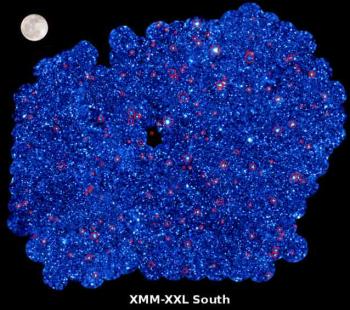News 2015
A new 3D map of galaxy clusters has just been published by a research team led by Maguerite Pierre from the Astrophysics Department-AIM Laboratory of CEA-IRFU through a survey of two regions of the sky, each covering about 25 square degrees (about 100 times the area of the full moon). The survey, called XXL, was conducted from 2011 to 2013 resulting from 543 observations of the X-ray satellite XMM-Newton and requiring over 6 million seconds exposure. The XXL survey helped to locate and identify 450 clusters of galaxies and 22 000 active galaxies. Galaxy clusters are the largest structures in the Universe, reaching masses of over a hundred thousand billion times the Sun's mass. Their number and distribution were studied up to distances of about 7 billion light-years when the universe was half its present age. The XXL survey found a significantly lower cluster density than predicted by cosmological models and a quantity of gas in these clusters also lower than expected. It also allowed the discovery of five new super-cluster or clusters of clusters of galaxies. These preliminary results are subject to a first series of 13 articles, published in a special issue of the journal Astronomy & Astrophysics (in press).
A team of researchers from CEA (Astrophysical Department and CEA-DAM) and the LUTH Laboratory (Paris Observatory) has just published a comprehensive study of an enigmatic phenomenon of quasi-periodic oscillations at the surface of strongly magnetic white dwarfs also called "Polars ". These dense stars are orbiting a companion and capture its material that falls freely toward the white dwarf poles. Strongly heated to millions of degrees, the hot gas or plasma then emits mainly in X-rays. Thanks to detailed numerical simulations of the plasma behavior, the researchers were able to reconstruct the existence of strong instabilities leading to rapid oscillations in the luminosity with timescales of only a few seconds. However, using the database of the XMM-Newton satellite, these oscillations were sought unsuccessfully by the team, in the X-ray emission of over 20 Polars. This contradiction leads today researchers to propose to study the phenomenon in the laboratory. Indeed, similar physical conditions can currently be replicated by large power lasers like the LMJ [1]. The control of plasma instabilities is a key element for nuclear fusion by magnetic (ITER experience) ou inertiel confinement (laser Mégajoule) and instabilities of white dwarfs could contribute to a better understanding of this general phenomenon. These results are the subject of two articles published in the journal Astronomy & Astrophysics, July 2015.
 |
see the movie of the numerical simulation (short version) |
A new 3D map of galaxy clusters has just been published by a research team led by Maguerite Pierre from the Astrophysics Department-AIM Laboratory of CEA-IRFU through a survey of two regions of the sky, each covering about 25 square degrees (about 100 times the area of the full moon). The survey, called XXL, was conducted from 2011 to 2013 resulting from 543 observations of the X-ray satellite XMM-Newton and requiring over 6 million seconds exposure. The XXL survey helped to locate and identify 450 clusters of galaxies and 22 000 active galaxies. Galaxy clusters are the largest structures in the Universe, reaching masses of over a hundred thousand billion times the Sun's mass. Their number and distribution were studied up to distances of about 7 billion light-years when the universe was half its present age. The XXL survey found a significantly lower cluster density than predicted by cosmological models and a quantity of gas in these clusters also lower than expected. It also allowed the discovery of five new super-cluster or clusters of clusters of galaxies. These preliminary results are subject to a first series of 13 articles, published in a special issue of the journal Astronomy & Astrophysics (in press).


